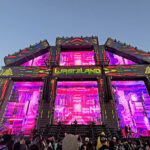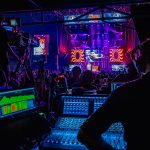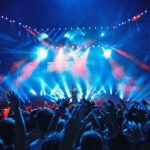For the last two years, I’ve had the opportunity to be involved with the Rock in Rio festival in different roles, giving me a unique perspective on the festival both in the U.S. and Portugal. In May 2015, I managed the front of house control system for the Palco Mundo (World Stage) in Las Vegas and assisted incoming LDs with everything from setting up their consoles, connecting them to the main data distribution system, providing timecode connections, programming support, etc., etc. I even punted for a couple of the bands that traveled without an LD.

One of the main functions I also had was to program for the nightly pyro/lighting/audio show that the festival played before the headline act. This gave me the opportunity to work directly with the festival’s LD, Terry Cook of Woodroffe Bassett Design (WBD).
This year, the opportunity to work with the festival came to me in a different form: I was asked to manage the pre-visualization suite in Lisbon by the PRG/XL Video team managing the event. Because we had used ESP Vision in the studio at Rock in Rio USA in 2015, the PRG/XL Video team was interested in using ESP Vision for previz in Lisbon and felt I was the right choice to oversee the studio. And I was not about to say no!

Rock in Rio’s History and Format
Rock in Rio began in 1985 in Rio de Janeiro, Brazil. Over the years, the festival alternated between Rio, Lisbon, and Madrid, and branched into the U.S. in 2015. Over the years, the festival has played host to most of the top performers in the business, including Queen, Metallica, and Bruce Springsteen to name a few. The festival’s attendance was estimated up to 1.5 million in its first year, with several hundred thousand fans lining up to attend the festival for each event when it is staged yearly.
The format of the festival is very similar regardless of its location. It has the Palco Mundo (the main stage for music), and the Palco Sunset (a second stage for live music) and, in recent years, the Eletrônica Palco (EDM Stage).
Some of the other fun features of the festival include:
- Live performance areas called Rock Street and Beat Street. They showcase internationally themed events, music and performances.
- There is the very large VIP tent that provides a bird’s eye view of the entire festival.
- There is the Ferris wheel that gives everyone a fun ride as well as great view of the grounds.
- There are food vendors, face painters, and roaming Rock in Rio “cheerleaders” tossing out goodies and interacting with the audience.
- There is the zipline feature that spans diagonally over the main stage audience and operates continually during the festival, including performances — something that can make running a followspot a little challenging.
- The festival has become instantly recognizable by its iconic main stage façade, which is made of gleaming shiny curved panels. In Lisbon, this stage measured approximately 95 feet high and 240 feet wide.
Previz for the Festival
The lighting packages in both locations were very similar as well, both being designed by Terry Cook, making my job in the previz suite easier because of its familiar layout. The previz suite in Vegas had two console stations, one for the main stage and one for the second stage. This was because in Vegas, the second stage booked popular acts well into the nighttime hours alongside the main stage. In Lisbon, however, the studio’s two console workstations were dedicated to the main stage. Having only to book time slots for one stage was way less complicated than it was in 2015, and we were easily able to accommodate all requests for the LDs to come in around the clock.
Prior to arriving on show site, I was able to reach out to all of the visiting LDs to find out when they would like to use the studio and what console they would be using. Because I had the experience last year of being at FOH, I also asked if they had any special requests for FOH like timecode, Art-Net lines for video, etc. Gathering this information ahead of time allowed us to be prepared both in the suite as well as FOH for their arrival and setup. And that is especially important, given that most of the LDs would not get any dark time at FOH due to the 24-hour schedule of shows and loadouts.

Preparing the Previz Suite
One of the important things to point out about most festivals is that the incoming bands have little to no time to work on the actual stage before their performance. This is why having a previz suite is so important. A couple of months prior to the show, I received the initial lighting plot from the main stage programmer Tobias Broecking and began creating the ESP Vision model to be used for pre-programming. Once I arrived onsite, I worked with the Vectorworks team who also supported the studio to check all physical orientations of the fixtures against the actual lighting rig to make sure that they matched the real world. After making the final adjustments to trim heights, distances between trusses, and angles of the side ladders, the model was open for business in the studio; and within 24 hours of arriving onsite, we had our first LD arrive.
Weeks out from the show, I sent out the patching paperwork to all of the LDs, and I passed on updates as they came to me. Once an LD arrived onsite, I confirmed with them all final changes while also making sure they had the correct console profiles for fixtures not found in their libraries (like the PRG Icon Beam). Some LDs brought their own consoles, while others used the existing console in the suite. For those who brought their own, I would also always try to send them the necessary network settings so they could configure their consoles ahead of time.

Managing the Suite on Show Site
My responsibilities during the festival were to help the LD get up to speed as quickly as possible once they arrived so they could put together something for a performance, usually later that same day. This ranged from helping troubleshoot patching errors to changing fixture types in the profiles and everything in between.
Many of the artists brought in additional lighting for their shows. While it’s not uncommon to have extra lighting, most of the LDs were using existing show files with programming for these lighting packages, so they didn’t require being drawn into the previz model. A couple of times, however, we did add additional lighting into the previz model for these floor lighting packages so that the LD could work with the entire rig.
Working with multiple LDs is fun in any country. I have many fun stories from Las Vegas working late at night with LDs like Rob Koenig, Cory FitzGerald and Davey Taylor, and now I have many more to add from working with LDs like Joel Reiff, Rob Sinclair, Brian Jenkins and Brent Clark. I love the camaraderie and the friendships that develop when working with your peers while watching, listening, and sharing tips and keystrokes with some of best in the business. And it’s also interesting to me to discover the preferred consoles of each of these guys. In Lisbon, in addition to the grandMA2, we saw the Hog4 on more than one occasion, the ChamSys MagicCue 100 and the Jands Vista. And I learned just how popular the Catalyst Media Server still is in Europe as well!

Overall, festivals are a lot of work. The hours are long (usually around the clock on show days), the weather can be challenging, the food can be less than appealing. But the energy in the air on show days is electric. When the entire team knows their job and supports each other, the machine will hum along nicely, making those days when Murphy strikes bearable.. or maybe it’s the beer in the studio’s fridge at the end of a long day. Either way, Rock in Rio is a legendary party no matter what country it’s in.



